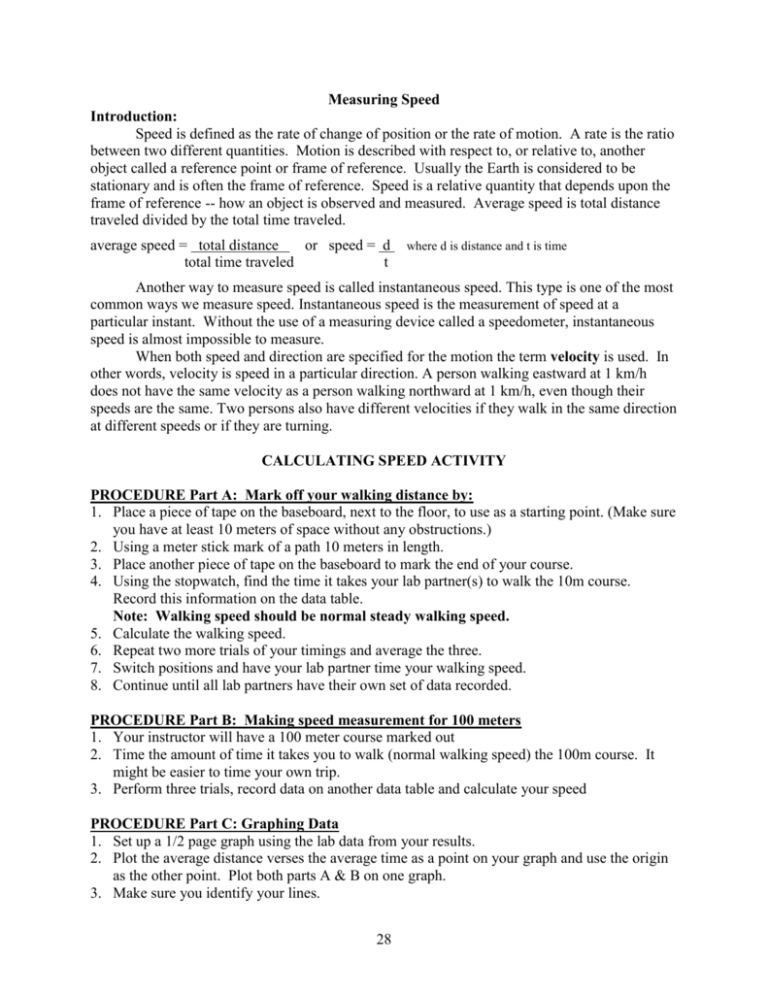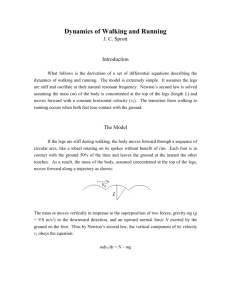Lab–Walk Speed
advertisement

Measuring Speed Introduction: Speed is defined as the rate of change of position or the rate of motion. A rate is the ratio between two different quantities. Motion is described with respect to, or relative to, another object called a reference point or frame of reference. Usually the Earth is considered to be stationary and is often the frame of reference. Speed is a relative quantity that depends upon the frame of reference -- how an object is observed and measured. Average speed is total distance traveled divided by the total time traveled. average speed = total distance or speed = d total time traveled t where d is distance and t is time Another way to measure speed is called instantaneous speed. This type is one of the most common ways we measure speed. Instantaneous speed is the measurement of speed at a particular instant. Without the use of a measuring device called a speedometer, instantaneous speed is almost impossible to measure. When both speed and direction are specified for the motion the term velocity is used. In other words, velocity is speed in a particular direction. A person walking eastward at 1 km/h does not have the same velocity as a person walking northward at 1 km/h, even though their speeds are the same. Two persons also have different velocities if they walk in the same direction at different speeds or if they are turning. CALCULATING SPEED ACTIVITY PROCEDURE Part A: Mark off your walking distance by: 1. Place a piece of tape on the baseboard, next to the floor, to use as a starting point. (Make sure you have at least 10 meters of space without any obstructions.) 2. Using a meter stick mark of a path 10 meters in length. 3. Place another piece of tape on the baseboard to mark the end of your course. 4. Using the stopwatch, find the time it takes your lab partner(s) to walk the 10m course. Record this information on the data table. Note: Walking speed should be normal steady walking speed. 5. Calculate the walking speed. 6. Repeat two more trials of your timings and average the three. 7. Switch positions and have your lab partner time your walking speed. 8. Continue until all lab partners have their own set of data recorded. PROCEDURE Part B: Making speed measurement for 100 meters 1. Your instructor will have a 100 meter course marked out 2. Time the amount of time it takes you to walk (normal walking speed) the 100m course. It might be easier to time your own trip. 3. Perform three trials, record data on another data table and calculate your speed PROCEDURE Part C: Graphing Data 1. Set up a 1/2 page graph using the lab data from your results. 2. Plot the average distance verses the average time as a point on your graph and use the origin as the other point. Plot both parts A & B on one graph. 3. Make sure you identify your lines. 28 DATA TABLE 1 Part A --- 10m walk Trial Distance (m) Time (sec) Speed (m/s) 1 2 3 Average DATA TABLE 2 Part B --- 100m walk Trial Distance (m) Time (sec) Speed (m/s) 1 2 3 Average QUESTIONS: 1. What is the formula for calculating speed (or velocity)? 2. What is your average walking speed for part A? 3. Using your 10 m graph, how long would it take you to walk? a. 30 m b. 45 m c. 100 m 4. Using the 10 m graph, how far would you walk in: a. 20 sec b. 30 sec c. 70 sec 5. Change the speed formula in question #1 so you could find time, if you were given speed & distance. time = ? 6. Using the formula from Question 4 and your average walking speed from Question 2, calculate the time it would take to walk : (1mile =1609 m) a.100 m b. 1000 m c. 10,000 m d. to your house 7. Change the speed formula in question #1 so you could find distance, if you were given speed & time. distance = ? 8. Using the formula from Question 7 and your average walking speed from Question 2, calculate the distance you walk in: a 30 sec b. 10 minutes c. 1 hour d. 1day 9. How does your 10 m average speed compare to your 100 m average speed? 10. The world record 100 m dash is 9.85 sec by LeRoy Burrell. a. What was his speed in m/s? b. How many miles per hour is this? (Note 1 mile = 1609m) c. Plot this point on your graph and draw a line. d. How does the slope of Leroy Burrell’s line compare to your walking speed slope? 29










